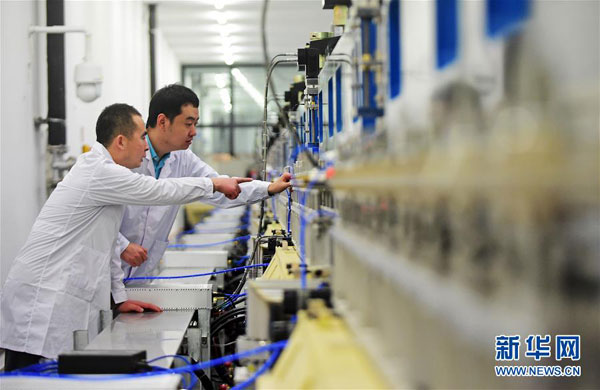China develops world's brightest EUV free electron laser
 |
|
Scientists adjust the facility that can generate 140 trillion photons per laser pulse in one picosecond in Dalian, Northeast China's Liaoning province, Jan 13, 2016. [Photo/Xinhua] |
Chinese scientists announced they have built a facility that can generate the world's brightest extreme ultraviolet (EUV) free electron laser.
The facility in Dalian, a coastal city in Northeast China's Liaoning province, can generate 140 trillion photons per laser pulse in one picosecond.
The Dalian Coherent Light Source (DCLS) facility was jointly built by the Dalian Institute of Chemical Physics and Shanghai Institute of Applied Physics under the Chinese Academy of Sciences (CAS) with a total investment of about 140 million yuan (about $20 million dollars).
The flashes of light will illuminate new aspects of the microscopic world. "EUV light sources are especially useful for sensitive detection of atoms, molecules and clusters," said Yang Xueming, a CAS academician and deputy director of the Dalian Institute of Chemical Physics.
Brightness and pulse duration of the light source are key to such detection. "The brighter the light source, the more clearly we can see the small number of atoms or molecules," said Yang.
"Since many physical, chemical and biological reactions happen on a time scale of femtoseconds or picoseconds, we need high-speed 'flashlight' to capture those moments to study the process," Yang said.
The DCLS will play a unique and important role in exploring the unknown material world and promoting technological progress, said Yang.
"EUV free electron laser light sources have wide applications in the study of basic energy science, chemistry, physics and atmospheric sciences. We expect that the facility will become a new tool for important scientific discoveries and international scientific collaboration," Yang said.
Among all the applications, research on the formation and growth mechanism of smog is likely to gain the most attention in China.
"The facility can help us study how small molecules grow into clusters, and then into smog. Better understanding the formation mechanism of smog is important to finding solutions to air pollution," the scientist said.
Zhang Weiqing, a researcher with the Dalian Institute of Chemical Physics, said the DCLS will also be used to study the chemical mechanism of burning, which will help improve the efficiency of energy utilization and reduce pollution emissions.
The facility is also expected to play an important role in developing the next generation of semiconductor chips, as well as investigating the structure and function of biomolecules, said Zhang.
Wang Enge, vice president of the CAS, said 90 percent of DCLS devices were independently developed in China, and its construction has laid the foundation for developing next generation free electron laser.



















